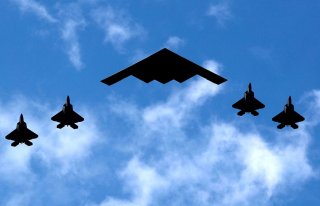The Air Force Has a Master Plan to Stop a Chinese Invasion of Taiwan
At first glance, the war game seemed to herald something of a turning point: for the first time in recent years, the U.S. military won a simulated conflict with China. However, that victory comes with serious caveats.
The U.S. Air Force finally has a plan for successfully repelling a Chinese invasion of Taiwan, but only at a steep cost.
China has spent the past decade gradually building up its strength against U.S. assets operating in the Pacific, but a series of earlier war games have shown just how drastically the regional balance of power has shifted in Beijing’s favor. Noting China’s growing success in countering U.S. power projection capabilities, Air Force Lt. Gen. Clinton Hinote offered a bleak assessment: “At that point, the trend in our war games was not just that we were losing, but we were losing faster . . . After the 2018 war game I distinctly remember one of our gurus of wargaming standing in front of the Air Force secretary and chief of staff and telling them that we should never play this war game scenario [of a Chinese attack on Taiwan] again because we know what is going to happen.”
“The definitive answer, if the U.S. military doesn’t change course” Hinote continued, “is that we’re going to lose fast. In that case, an American president would likely be presented with almost a fait accompli.”
The Air Force concluded that a fundamentally different approach is needed. The service repelled a Chinese invasion of Taiwan with a roster of advanced drones and next-generation fighters during a war game held late last fall, according to Defense News. This networked, survivable force spearheaded the defense of Taiwan, rebuffing the Chinese invasion force and thus blocking Beijing from realizing its long-held strategic goal of absorbing the island nation to its east.
At first glance, the war game seemed to herald something of a turning point: for the first time in recent years, the U.S. military won a simulated conflict with China. However, that victory comes with serious caveats. First, any such conflict implies substantial losses for both the U.S. and Taiwanese sides. “The force that we had programmed, say, in 2018 took devastating losses. This force doesn’t take those devastating losses. They do take losses. We do lose a lot of airmen. It is a difficult fight,” Hinote said. “And that kind of gets to the point of what does it take to stand up to China in the Indo-Pacific, literally on their front doorstep. And the answer is: It takes a willingness to be able to suffer those losses. It’s just a difficult, very sobering reality that we have.” The United States would have to deploy as much as 80 percent of its Navy and Air Force to win a pitched conflict with China in the South and East China Seas, where the latter enjoys significant logistical and operational advantages, according to an estimate by Lu Li-shih, a former instructor at Taiwan’s Naval Academy in Kaohsiung.
But there is yet another problem: the U.S. military won the war game in large part with technology it does not currently possess, and under assumptions that may not hold up in real-life circumstances. The upcoming Next Generation Air Dominance (NGAD) fighter played a key role in high-risk penetration operations into enemy airspace, as did several types of autonomous “loyal wingman” drones that are currently either in the development or acquisition stage. The simulation’s force composition and deployment patterns were partially pre-determined in a way that is beneficial to the U.S. side. The war game also assumed that the military had fully implemented its ongoing Joint All Domain Command and Control, allowing U.S. assets to fight as an interlinked force; it likewise presumed certain future defense investments on the part of Taipei.
The war game signals a step in the right conceptual direction, but there is much more work to be done—both in terms of strategic planning as well as ongoing defense investments—if Washington is to acquire the capability to credibly deter and defeat a Chinese invasion of Taiwan.
Mark Episkopos is a national security reporter for the National Interest.
Image: Reuters

